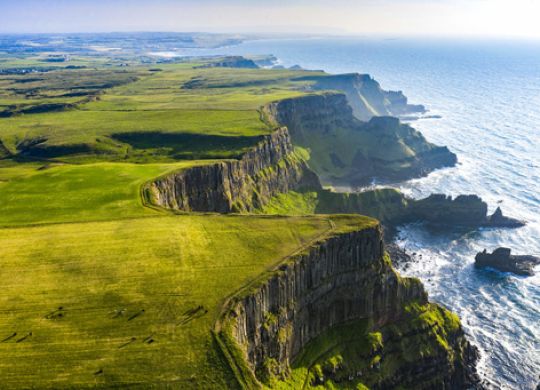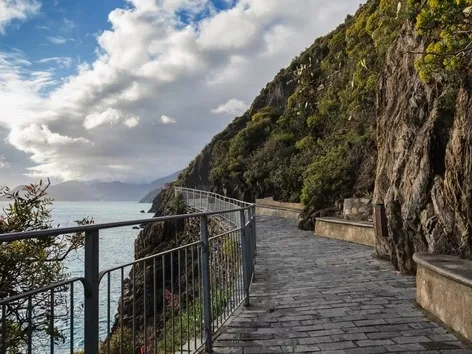Top 10 must-see places in Ireland

Ireland attracts millions of tourists from all over the world with its ancient haunted castles, luxurious mansions, emerald meadows with sheep, rocky cliffs, and cheerful, noisy pubs. It's easy to get lost in such a variety of attractions. Learn more about the top 10 must-see places in Ireland for tourists
Ireland, a small country in the north of Europe, receives about 6.2 million tourists every year, which is significantly more than its population. This is a clear indicator of the popularity of this place among travelers. In 2011, the readers of the famous Lonely Planet magazine recognized Ireland as the best vacation spot in the world, which adds another argument for a visit. According to statistics, the largest number of tourists arrive in Ireland from the UK, USA and Germany.
A trip to Ireland usually starts in its largest city, Dublin, where almost a quarter of the country's population lives. This city fascinates with its unique architecture and inimitable charm, which distinguishes it from other European capitals.
Another popular city among tourists is Cork, known for its ancient history, famous residents, and numerous attractions. Ireland has a lot to offer for tourists: medieval Gothic castles, majestic cathedrals, unique natural attractions, as well as rich culture and local customs. So keep reading about our selection of the best locations in Ireland.
You can learn more about how to get to Ireland and the top locations to visit by following the link.
1. The Cliffs of Mogher, County Clare
One of the most breathtaking places in the world is the Cliffs of Mogher, which attract millions of tourists every year with its grandeur and beauty. Walking along the trail along the cliffs offers incredible views and great photo opportunities.
The Cliffs of Mogher, which stretch along the coast of Ireland, have been repeatedly recognized as the most popular tourist destination in the country. This place has become famous for its participation in many music videos, commercials and movies, including the famous movie hit "Harry Potter and the Half-Blood Prince". This added to their popularity among tourists who want to see these picturesque places with their own eyes.
Scientists claim that the Moger Cliffs were formed about 320 million years ago. They consist of Namur shale and sandstone, which were deposited for a long time in an ancient sea basin. Over time, these sediments compacted and turned into the sedimentary layers that can now be seen above the ocean.
However, these rocks can be quite dangerous. Every year, accidents with tourists occur here, and this year the Moger Cliffs were included in the top ten most "deadly" natural attractions in the world. Despite the safe footpaths and warning signs, some tourists still risk getting close to the edge.
This place is really worth all the time, effort and money spent. Once you visit it, you will definitely want to come back again, because it is impossible to see all the sights in one visit. Each stop for photos or just to admire the scenery is addictive. In addition, the rocks look different in different weather, and getting here on a sunny day is considered a great success, especially in June and July.
2. Temple Bar, Dublin
Temple Bar, which took second place in the ranking, is one of the most famous neighborhoods in Dublin. The name "Temple Bar" refers not only to the famous bar, but also to the entire neighborhood filled with pubs, fun companies and live music. The Temple Bar remains the most photographed place here, and you can watch the life around it through a street camera.
This is one of the oldest neighborhoods in Dublin, where dozens of restaurants, bars, nightclubs and shops are concentrated. The fun never stops here, and on St. Patrick's Day, the streets are filled with celebrants singing songs and moving from one bar to another.
Temple Bar is famous for:
1. The Brazen Head, the oldest pub in the Irish capital, opened in 1198;
2. The Clarence Hotel, owned by members of the U2 band;
3. Smock Alley Theater, one of the oldest theaters in Europe;
4. The New Theater, the smallest theater in Ireland.
This neighborhood is incredibly atmospheric and fun, so it definitely deserves your attention during your visit to Dublin.
3. Howth, County Dublin
Howth is a cozy coastal town known for its excellent restaurants and scenic cliff walks, which run alongside the Baily Lighthouse.
This place with a population of about 9 thousand people attracts tourists primarily for its lighthouse with a red door, which can be approached closely, which is rare for Irish lighthouses. In good weather, there are many more tourists here, and you can spend a lot of time taking photos.
Next to the lighthouse there is a marina and a large promenade where you can see fur seals in the coastal waters. This place is perfect for taking beautiful photos as a souvenir.
Hout is also famous for its numerous restaurants for every budget, serving delicious fish and seafood dishes. Fishing has always been the main occupation for the locals, so it is not surprising that most tourists come here for gastronomic experiences.
Howth can be reached in half an hour by train from the center of Dublin. A round-trip ticket costs about 5 euros and can be purchased at the train station.
4. Trinity College Dublin
Trinity College Dublin, founded in 1592, is one of the oldest and most prestigious higher education institutions not only in Ireland but also in the world. Over its long history, this university has graduated many famous personalities, including Jonathan Swift and Oscar Wilde. Interestingly, Trinity College was one of the first European higher education institutions to open its doors to women.
Among the university's attractions, a special place is occupied by the Kell Book, but the most photogenic place is the Long Room of the Old Library. This majestic hall impresses with its high ceilings, shelves filled with ancient books, and the atmosphere of a true academic environment.
Visitors to the university not only have the opportunity to see rare books and manuscripts, but also to feel the spirit of history and academic traditions that have been passed down from generation to generation. Trinity College remains a symbol of educational excellence and cultural heritage of Ireland.
5. Dingle, County Kerry
Dingle is one of the smallest but most colorful peninsulas in the south of Ireland. This region impresses with its rugged ocean landscape, inaccessible cliffs and winding roads that contrast with picturesque villages and friendly dolphins. One of the most popular places among photographers is the Dun Chaoin Pier. If you're lucky, you can see a flock of sheep climbing a narrow path.
Dingle, located on the peninsula of the same name, immediately attracts attention with its colorful houses and well-groomed streets. The city became famous for a dolphin that settled in the bay a few years ago - a monument was erected in its honor on the waterfront. The town is characterized by more than fifty pubs, which is surprising given the population of less than 2000 people.
The local St. Mary's Church has an unusual bell tower that resembles a fortress tower. The city also houses the Institute of Celtic Culture in a magnificent old mansion. Dingle is surrounded by picturesque nature: green hills on one side and a rocky coast on the other. 8 km from the city, in the village of Gallarus, there is a unique early Christian church, which is considered one of the oldest and most interesting buildings in Ireland. Nearby you can see a castle tower of the XV century, which adds even more historical charm to this region.
6. Phoenix Park, Dublin
Phoenix Park is a huge forest in Dublin, home to several hundred fallow deer that move freely and are not afraid of people. Phoenix Park is the largest enclosed urban park in Europe, covering an area of 709 hectares. It is a favorite place for outdoor recreation among Dubliners.
The park is home to the official residence of the President of Ireland - Áras an Uachtaráin, Farmleigh House, Deerfield Residence, Dublin Zoo and the Victorian People's Flower Gardens.
In the park you will find many historical monuments, such as Áras an Uachtaráin (residence of the President of Ireland) and Deerfield Residence (residence of the US Ambassador), majestic buildings of the XVIII century. The impressive 35-meter-high Papal Cross, erected in 1979 in honor of the Pope's visit to Ireland, and the Duke of Wellington Testimonial are also located here. In addition, you can visit the Magazine Fort, built in 1611, which offers a magnificent view of the valley.
Planning a trip or move abroad? An important part of a successful trip is an insurance policy, as it guarantees high-quality medical care anywhere in the world and can protect you from unnecessary expenses while travelling. You can buy insurance from trusted agents on the Visit World portal.
7. Glendalough, County Wicklow
Glendalough, known as the Valley of Two Lakes, is fascinating for its glacial beauty, wildlife and ancient monastic settlement of the VI century. This green valley, formed by a glacier in prehistoric times, became a refuge for St. Kevin, who, together with other monks, built a monastery here. It is suggested to take a simple but rather long route to the source of the upper lake to enjoy the incredible views.
The monastery in Glendalough operated until the XIII century, when it was destroyed by English troops. Today, it is a tourist center where visitors can see the ancient double stone gate, a cross carved on the wall near the gate, which is considered the oldest symbol of Christianity, and a thirty-meter round tower with an entrance at the height of two human heights.
Near the church of St. Kevin there is a small cemetery where monks and local wealthy residents were buried. The nature in Glendalough is very quiet and peaceful, rich in green spaces and fresh air, making it an ideal place to relax from the bustle of the city.
8. Guinness Beer Museum, Dublin
One of Dublin's most famous landmarks is the Guinness Brewery, which attracts not only beer lovers but also those who don't drink it. This interactive museum, located in a former brewery building, is the most visited place in Ireland. On seven floors of the museum, there are expositions that tell in detail about the Guinness beer production process, its history and brand traditions.
Visitors can see a collection of beer barrels, listen to lectures on the dangers of alcohol and, of course, taste the most famous Irish beers in the Gravity Bar, which offers a panoramic view of Dublin. There are also restaurants, bars and souvenir shops. The tasting room offers training in the proper use of Guinness, and in the Academy on the fourth floor you can learn how to pour beer and even get a bartender certificate.
Lovers of spirits will also appreciate a tour of the former Jameson whiskey factory. The program includes fascinating stories about the history of the brand, explanations of the production process, and tasting of several whiskeys.
9. Kinsale, County Cork
Kinsale is one of the most beautiful towns in Ireland, known for its colorful houses, numerous restaurants and rich history. This city attracts attention not only with its colorful facades, but also with its millennial history, as it was home to the Celts, Vikings, and Normans. The streets of Kinsale are buried in greenery and flowers, creating a unique atmosphere.
Among the most prominent historical monuments is the Church of St. Malta, built by the Normans in the XII century on the basis of Celtic foundations. Desmond Castle, built in the 16th century, originally served as a customs office and later became a military prison. Today it houses the International Museum of Winemaking.
Kinsale is also famous for its gastronomic achievements. This city is called the gastronomic capital of Ireland due to the large number of restaurants and culinary festivals such as Gourmet. Walking around the city, visiting the forts with interesting and sad history for the Irish, as well as an excursion to the Old Head will leave an unforgettable experience for the whole day.
10. Blarney Castle, County Cork
Blarney Castle, located in the south of Ireland, is known not only for its magnificent mansion and beautiful gardens, but also for the Stone of Eloquence. Legend has it that anyone who kisses this stone will receive the gift of eloquence. The stone is part of the famous Skunk Stone, which was brought to Ireland as a result of historical events.
The castle, located on a hill, has underground passages and a small lake nearby, which adds to its medieval charm. Tourists from all over the world come here to take part in the ritual of bending down and kissing the sacred stone in the wall. This tradition dates back to the reign of Elizabeth I and has been alive for five centuries.
For many years, these lands belonged to the McCarthy family. During the Battle of Bannockburn, King Cormac McCarthy of Munster sent 4000 of his soldiers to help the King of Scotland. After the victory, the Scottish monarch presented Cormac with half of the Skunk Stone, which was used for the coronation of kings. This stone became the famous Stone of Eloquence in Blarney Castle.
We remind you! Edinburgh, the capital of Scotland, is a top tourist destination that attracts millions of visitors every year. Read more about what to do and where to stay in Edinburgh in 2024.
Are you planning to travel or move abroad? An important component of a successful trip is a travel insurance policy, because it guarantees the provision of high-quality medical care in any corner of the world and is able to protect you from unnecessary expenses during the trip. You can buy insurance from verified agents on the Visit World portal.
Products from Visit World for a comfortable trip:
Travel guide for 200 countries;
Legal advice from a local specialist on visa and migration issues;
Travel insurance around the world (please select the country of interest and citizenship to receive services);
Medical insurance all over the world.
We monitor the accuracy and relevance of our information, so if you notice any errors or inconsistencies, please contact our hotline.
Recommended articles
2 min
Travels
Vacation to Scotland in 2024: tourist attractions and the most interesting entertainment
Edinburgh, the capital of Scotland, is a top tourist destination that attracts millions of visitors every year. With its rich history, stunning architecture, vibrant gastronomy and breathtaking natural landscapes, it's no wonder that Edinburgh is one of the most popular tourist destinations in the world. Find out what to do and where to stay in Edinburgh in 2024
06 Aug. 2024
More details1 min
Travels
The "Way of Love" tourist trail was closed in 2012, all this time the route was undergoing reconstruction. Find out what Via dell'Amore is known for and how to book a ticket for one of Italy's most popular routes
06 Aug. 2024
More details3 min
Air travel
Traveling with your dog by plane: a detailed guide
Do you want to finally relax and recharge your batteries for a new trip, but aren't ready to leave your pet at home? You don't have to, because your furry friend can travel with you! Learn more about the rules for transporting dogs on an airplane
06 Aug. 2024
More details2 min
Travels
The best cities in Europe for your unforgettable honeymoon
Your honeymoon will be the beginning of your married life, so it's extremely important to make this vacation enjoyable and memorable. Find out more about the top 5 cities in Europe for a great honeymoon
07 Aug. 2024
More detailsAll materials and articles are owned by VisitWorld.Today and are protected by international intellectual property regulations. When using materials, approval from VisitWorld.Today is required.
